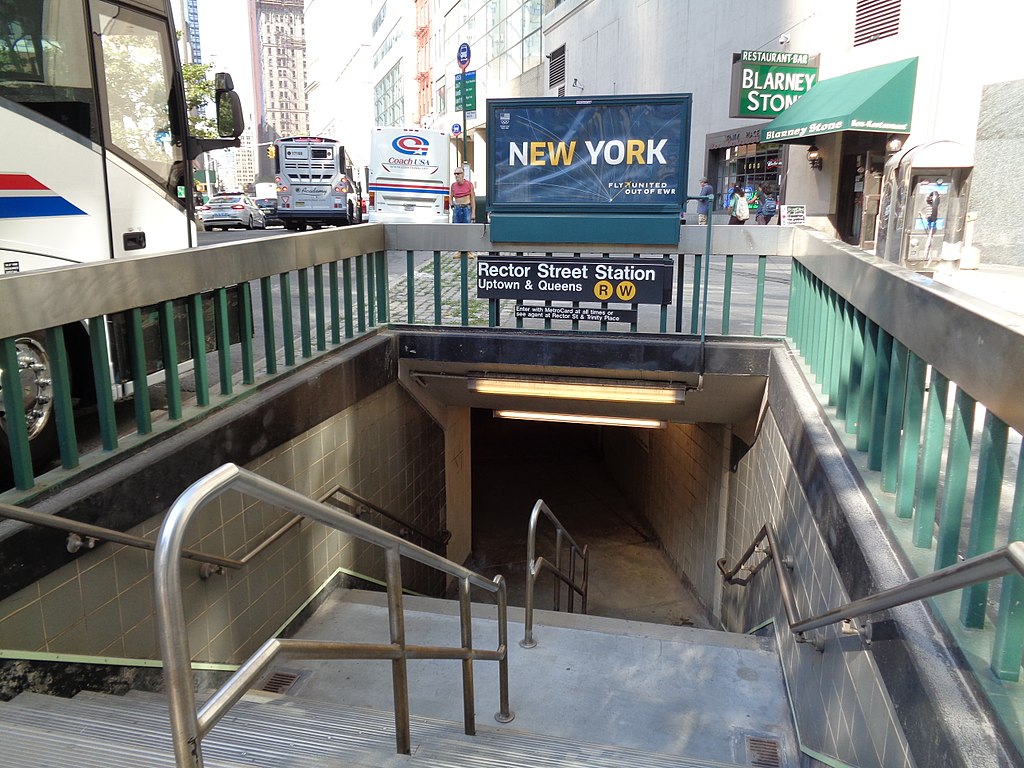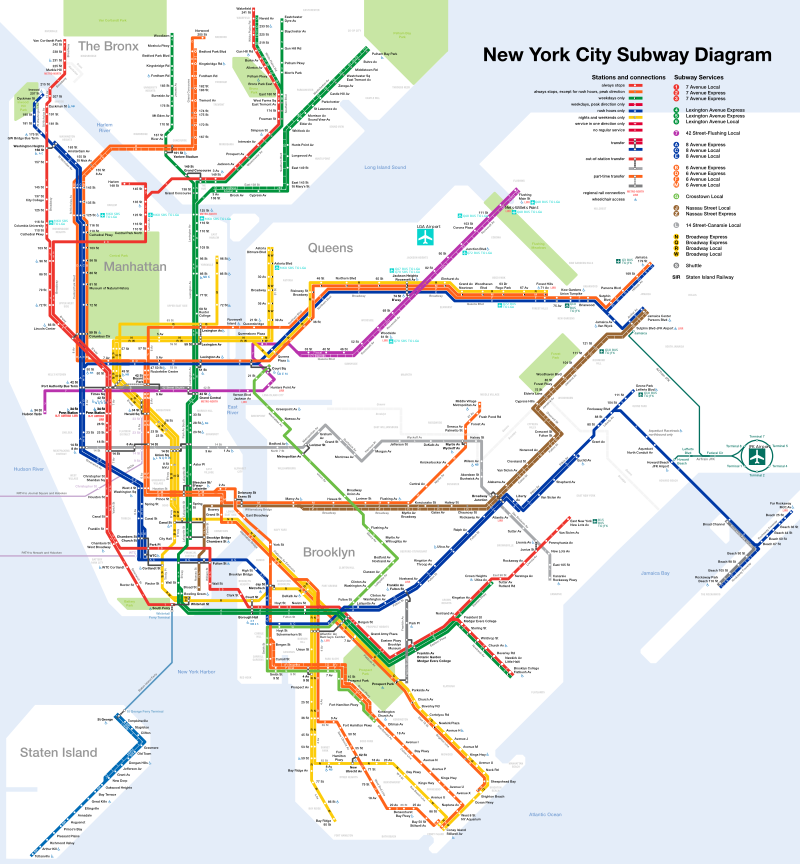NYC Subway Rector Street Station – Rector Street Station serves as a crucial transit point for commuters and tourists alike, offering easy access to some of New York City’s most significant landmarks and financial institutions.
NYC Subway Rector Street Station
- Location: Intersection of Rector Street and Greenwich Street in Lower Manhattan, New York City.
- Lines Served: 1 train.
- Opened: July 1, 1918.
Station Features
- Platform Layout: Two side platforms serving two tracks. The northbound platform is slightly longer than the southbound platform.
- Accessibility: Currently, the station is not equipped with elevators, making it inaccessible for those with mobility impairments.
- Entrances and Exits:
- Rector Street and Greenwich Street: The primary entrance/exit with staircases leading down to the platforms.
- Rector Street and Trinity Place: An additional entrance/exit near the northbound platform.
- Mezzanine: There is a small mezzanine area with fare control, turnstiles, and token booths.
Design and Aesthetics
- Tile Work: Features typical early 20th-century subway tile work with white tiles, accenting bands, and mosaic name tablets reading “RECTOR ST.”
- Signage: Standard black station signs with white lettering for directions and exits.
Nearby Points of Interest
- Trinity Church: Historic church located a few blocks north of the station.
- Battery Park: Located to the south, offering views of the Statue of Liberty and access to ferry services.
- Wall Street: The financial district is within walking distance, with the New York Stock Exchange nearby.
- World Trade Center: Just a short walk north, providing access to the 9/11 Memorial & Museum.
Connectivity
- Transfers: No direct in-station transfers to other subway lines, but several nearby stations offer transfers, including:
- Cortlandt Street (1 train, connected by underground passage).
- Wall Street (4 and 5 trains).
- Rector Street (R and W trains, located one block east on Trinity Place).
Additional Notes
- Busy Times: Like many Lower Manhattan stations, Rector Street sees heavy usage during rush hours due to its proximity to business districts and tourist attractions.
- Historical Significance: The station is part of the original IRT system expansion and has retained much of its historical character.
New York Subway Rector Street Station Map
What Train Goes to Rector Street
Rector Street station in Lower Manhattan is served by the following trains:
- 1 Train: This station is on the IRT Broadway–Seventh Avenue Line and provides local service.
Additionally, there’s another Rector Street station on the BMT Broadway Line:
- R and W Trains: These trains serve the Rector Street station located at the intersection of Rector Street and Trinity Place.
Both stations provide convenient access to different parts of Lower Manhattan, including the financial district and nearby attractions like Battery Park and the World Trade Center.
History of NYC Subway Rector Street Station (IRT Broadway–Seventh Avenue Line)
Early Development and Opening
- Planning and Construction: The IRT Broadway–Seventh Avenue Line was part of the Dual Contracts, agreements made in 1913 to expand the city’s subway system. The line was designed to alleviate congestion on existing lines and extend service to new areas.
- Opening Date: Rector Street station opened on July 1, 1918, as part of the first segment of the Broadway–Seventh Avenue Line to open, running from Times Square–42nd Street to South Ferry.
Design and Structure
- Architectural Features: The station features typical early 20th-century design elements with white tile walls, mosaic name tablets, and decorative elements consistent with other stations built during this era.
- Platform Layout: It has two side platforms serving two tracks. The design allowed for efficient passenger movement, accommodating the increasing number of riders traveling to and from Lower Manhattan.
Changes and Renovations
- 1940s and 1950s: As the subway system expanded and technology improved, the station underwent several upgrades to enhance safety and capacity. This included improved lighting, updated signage, and platform extensions to accommodate longer trains.
- 2001: After the September 11 attacks, the station was closed for several months due to its proximity to the World Trade Center site and the subsequent damage to the surrounding infrastructure.
- Post-9/11 Reconstruction: The station was reopened after extensive repairs and modifications. The reconstruction efforts focused on modernizing the infrastructure while preserving the historical aspects of the station.
Recent Developments
- 2000s to Present: In recent years, the MTA has continued to maintain and improve the station, ensuring it meets current safety and accessibility standards. However, as of now, the station is not fully accessible to people with disabilities, lacking elevators and ramps.
- Resilience Upgrades: Post-Hurricane Sandy in 2012, the MTA implemented additional measures to protect the station from future flooding and natural disasters, part of a broader effort to make the subway system more resilient.
Historical Significance and Nearby Landmarks
Importance in the Subway System
- Commuter Hub: Located in the heart of Lower Manhattan, Rector Street has always been a key station for commuters working in the Financial District and nearby office buildings.
- Tourist Access: The station provides convenient access to popular tourist destinations such as the World Trade Center, Battery Park, and the Statue of Liberty ferry.
Notable Nearby Landmarks
- Trinity Church: An iconic historic church located a few blocks north of the station.
- Wall Street: The financial hub of the United States, located within walking distance, housing the New York Stock Exchange.
- World Trade Center Complex: Including the 9/11 Memorial & Museum, a significant site of remembrance and modern architectural development.
- Battery Park: A large public park at the southern tip of Manhattan offering scenic views and recreational opportunities.
Rector Street station on the IRT Broadway–Seventh Avenue Line has a rich history intertwined with the development of New York City’s subway system and the growth of Lower Manhattan. From its opening in 1918 to its recovery after the 9/11 attacks and subsequent modernization efforts, the station remains a vital transit hub for both daily commuters and visitors exploring the historic and financial heart of the city.
![NYC Subway Map [New York Subway Map] ❤️](https://nycsubwaymap.net/wordpress/wp-content/uploads/2023/12/NYC-Subway-Logo.png)

